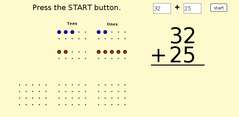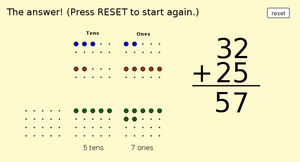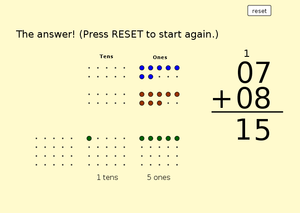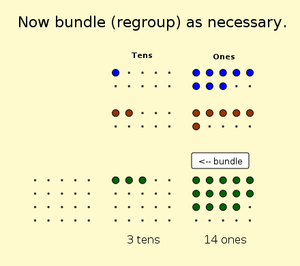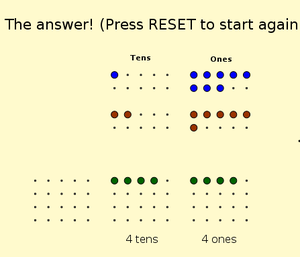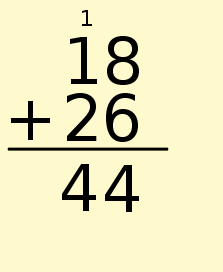Difference between revisions of "Addition using Place value and Standard Algorithm"
m (added Category:TIIE using HotCat) |
|||
| Line 18: | Line 18: | ||
==== '''Addition of the numbers when the sum is less than 10.''' ==== | ==== '''Addition of the numbers when the sum is less than 10.''' ==== | ||
| − | The facilitator recalls the representation of the given numbers in flat long units before going to addition. To know the previous knowledge in the addition the facilitator asked few questions which are used in their daily life like if a child has 3 note books and 2 text books | + | The facilitator recalls the representation of the given numbers in flat long units before going to addition. To know the previous knowledge in the addition the facilitator asked few questions which are used in their daily life like if a child has 3 note books and 2 text books. How many total books are with you? the students answers as 5 books, from this the facilitator explains the meaning of addition. To explain addition of two numbers the geogebra file of flat long units was used.The facilitator gives two representation of units to identify the number. |
° ° ° ° ° ° the students answered as 6 units | ° ° ° ° ° ° the students answered as 6 units | ||
Revision as of 10:25, 24 January 2023
Objective:
- able to recall the flat long units for the given numbers.
- able to solve single digit,double digit,three digit addition with carry over.
- able to solve single digit,double digit,three digit addition without carry over.
- To analyze how to solve addition using standard algorithm.
- Able to compare the answers of flat long units and standard algorithm while solving addition.
Materials:
geogebra file
process:
The whole classroom was divided into small groups based on the level of the learner, each group contains 8-10 students and a facilitator. Based on the level of the students the facilitator try to help the students from their basic concept/previous concept. To introduce addition to students the facilitator planned to use the flat long units and connect it to addition with flat long units, standard algorithm. The same concept was tried to explain in different methods.
Addition without carry over
Addition of the numbers when the sum is less than 10.
The facilitator recalls the representation of the given numbers in flat long units before going to addition. To know the previous knowledge in the addition the facilitator asked few questions which are used in their daily life like if a child has 3 note books and 2 text books. How many total books are with you? the students answers as 5 books, from this the facilitator explains the meaning of addition. To explain addition of two numbers the geogebra file of flat long units was used.The facilitator gives two representation of units to identify the number.
° ° ° ° ° ° the students answered as 6 units
° ° from this the students answered as 2 units
the facilitator ask what is the total number of units, the students answers as 8 units. units of two different numbers gets added when the sum is less than 10.
Later it was connected to the standard algorithm of addition to solve the sums. like 6+ 2=8.
It helps students to co-relate that both the answers are same. At the end some of the sums was given to practice it.
For the same concept different methods were used like grouping the students and telling them to write the numbers in a chit and passing the chits to different students to solve it,students themselves had to choose the number and solve it, the facilitator gives different representation to all the students and have to solve it.
For example: 4+5=9; 3+4=7; 6+2=8.
Addition of the numbers when the sum is greater than 10.
By recalling the previous knowledge with the students the facilitator asked the students to tell any two digit number for two different students and other students had to write the number and represent in the form of flat long units, for example 32 and 25. With the same numbers the facilitator showed a geogebra file which was represented in flat long units.
The facilitator explained how to add the units of first number to the units of second number that is two and 5 whose sum is 7 and tens of first number to the tens of second number that is 3 and 2 whose sum is 5. The sum was also represented in flat long units. The facilitator gives few sums for all the students in the form of flat long units and tell them to solve it.
Later the teacher explain how to solve sums using standard algorithm for the same numbers, this helped the students to get exposure to different methods of solving. some different questions was given to each student by the facilitator for the practice.
For example: 16+21=37; 43+51=94; 74+10=84.
Addition with carry over
Addition with carry over for single digit
By recalling the previous knowledge in addition without carry over the facilitator writes two numbers in the form of flat long units on the black board or shows in geogebra file and ask the students to identify the numbers that is 7 and 8. now the facilitator ask the students to add both the units and they answered as 15 units which was also represented in the form of flat long units. the facilitator ask are the units lesser than 10? students answers no, the units are more than 10.
So children what should be do when the units are more than 10? the students answers to group them in one tens. The facilitator explains the grouping of numbers when the sum is more than 10, by this the sum of 7 and 8 will have 1 tens and 5 units as remaining.
For example : 7+8=15
Addition of two digit numbers
from the previous knowledge of the two digit addition without carry over the concept of addition was introduced. The teacher considered any two numbers for example 18 and 26 and asked the students to represent it in flat long units and add the units and tens. The students came up with 14 units and 3 tens.
The facilitator asks the students what do observe in units. Students answers that the units are more than 10 then facilitator asks can we regroup it again? The students answers yes it can be made into tens and units. Later the facilitator explains that that regrouping tens can be taken to tens place and gets added.
Similarly it was explained by considering few examples and few sums was given for the students to solve it.
This method was related to the place value of addition and the standard algorithm was explained to make them understand why we do we take carry in the addition if the ones digit is 10 or more than 10 and why 1 is taken to tens place as carry
